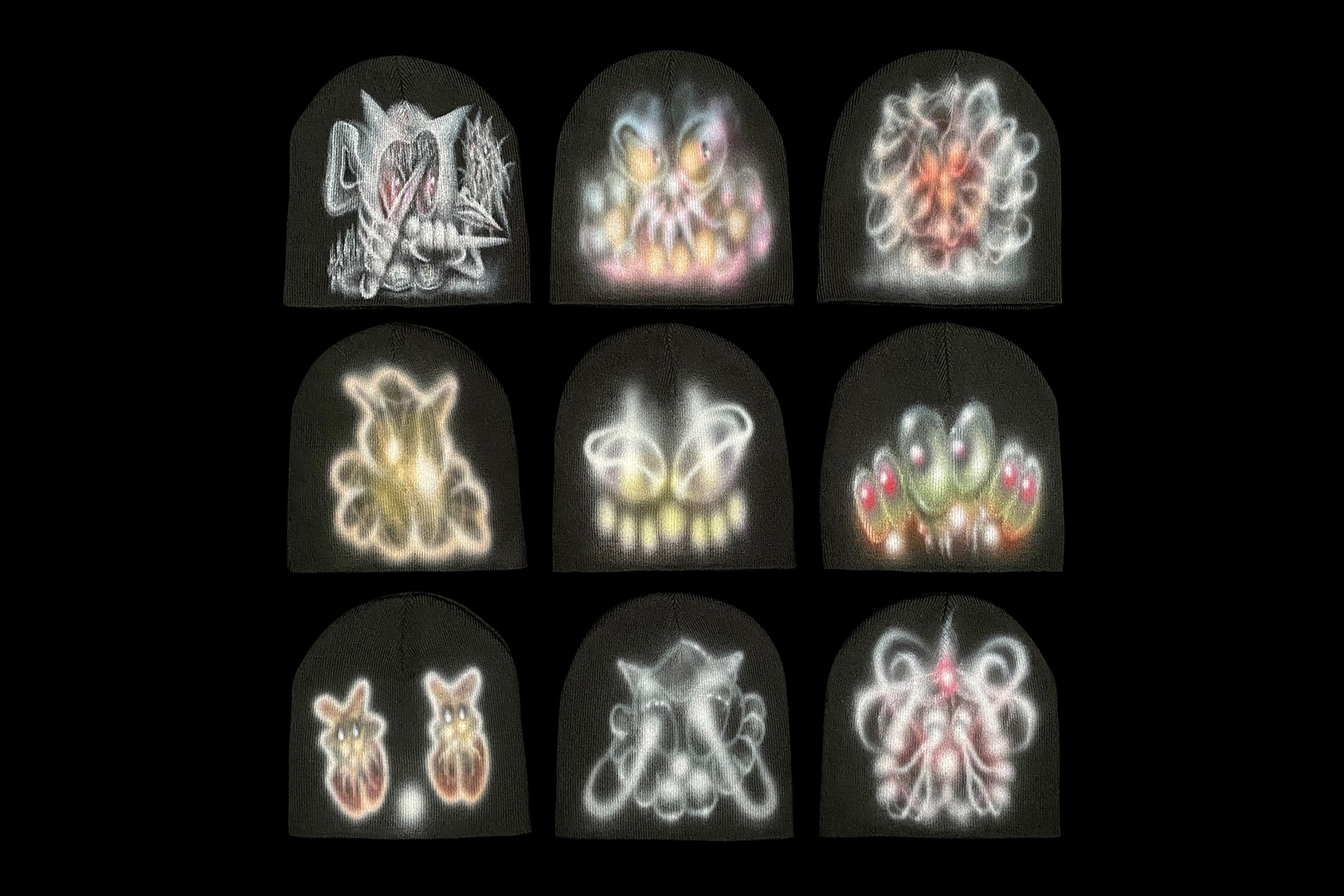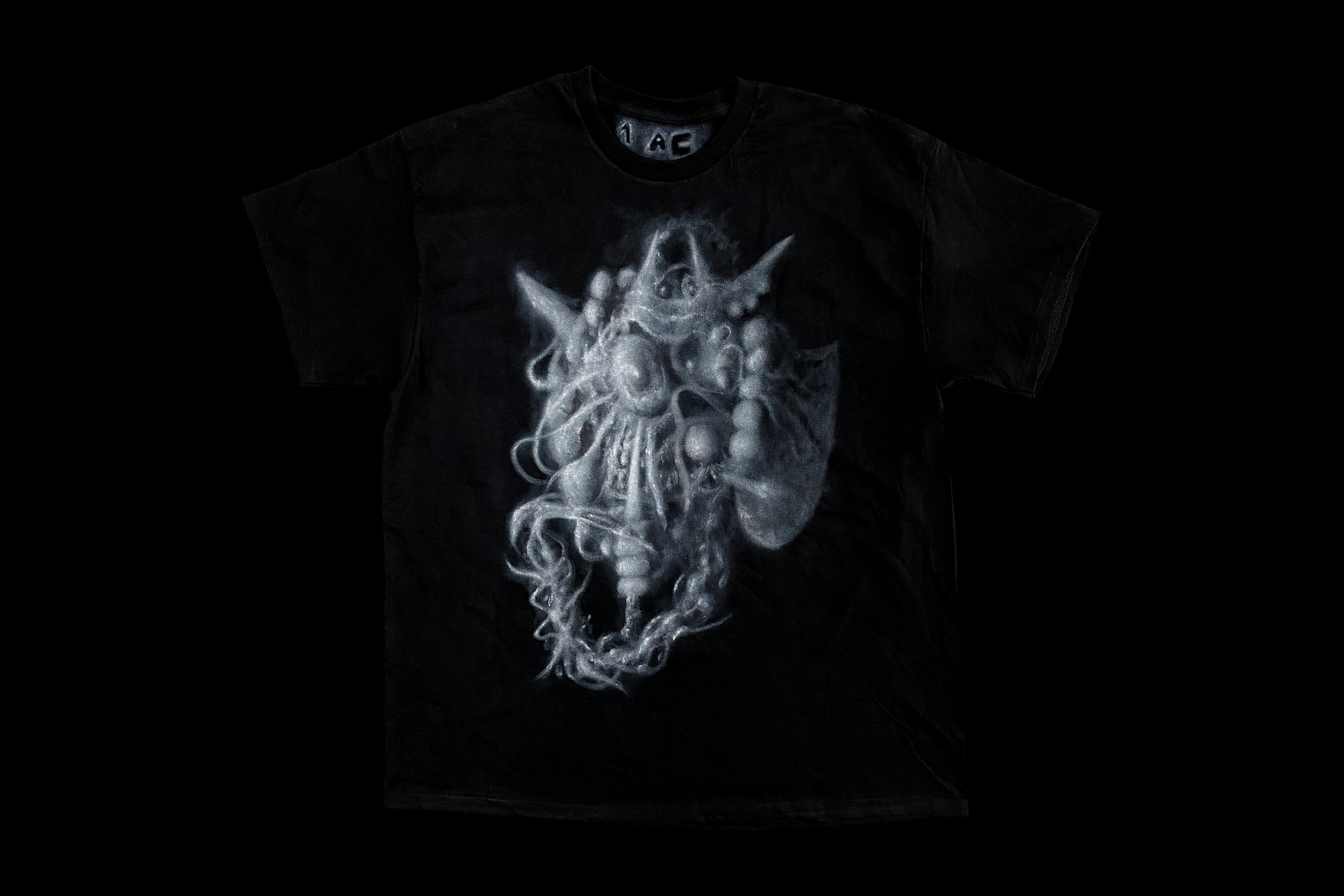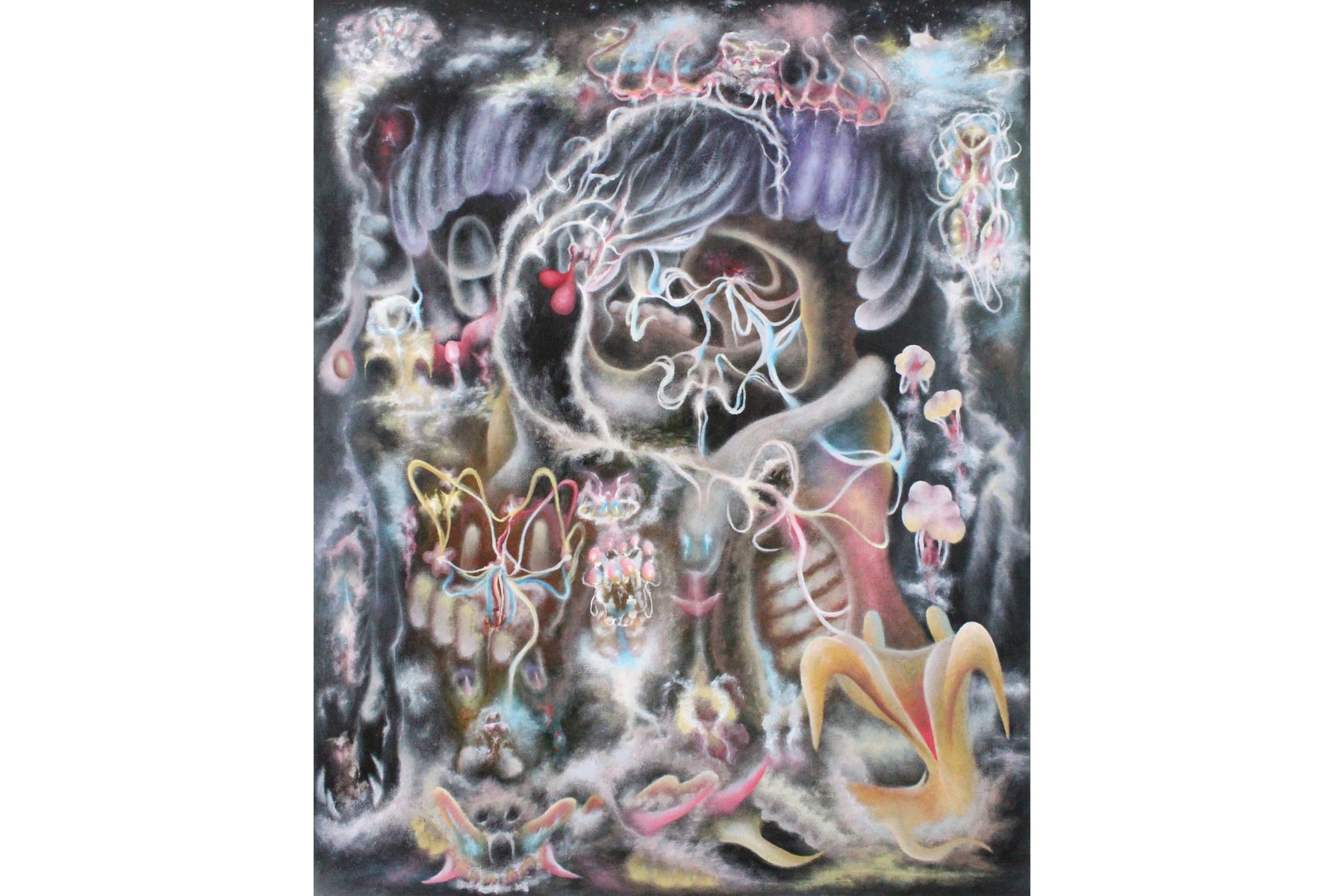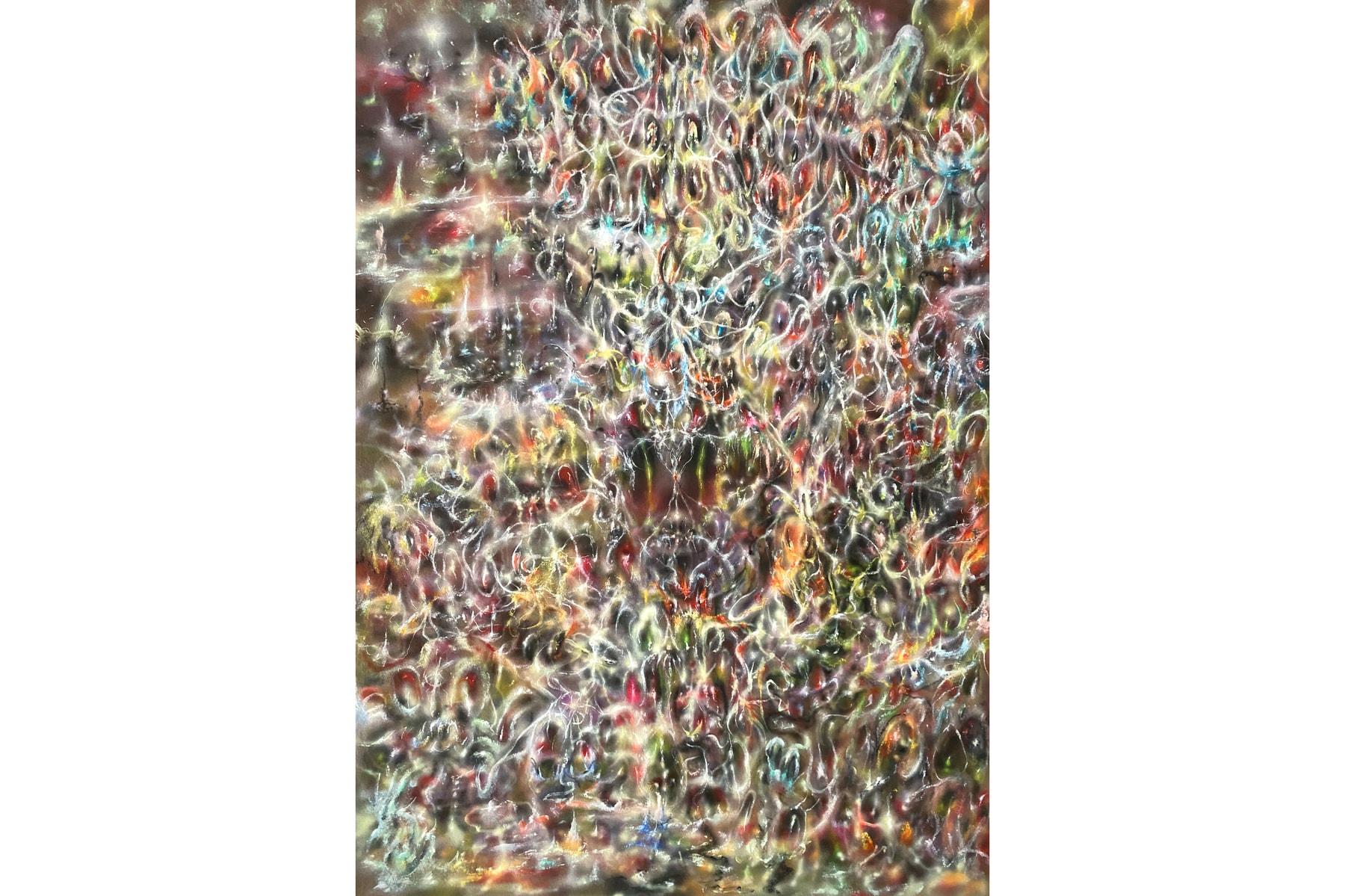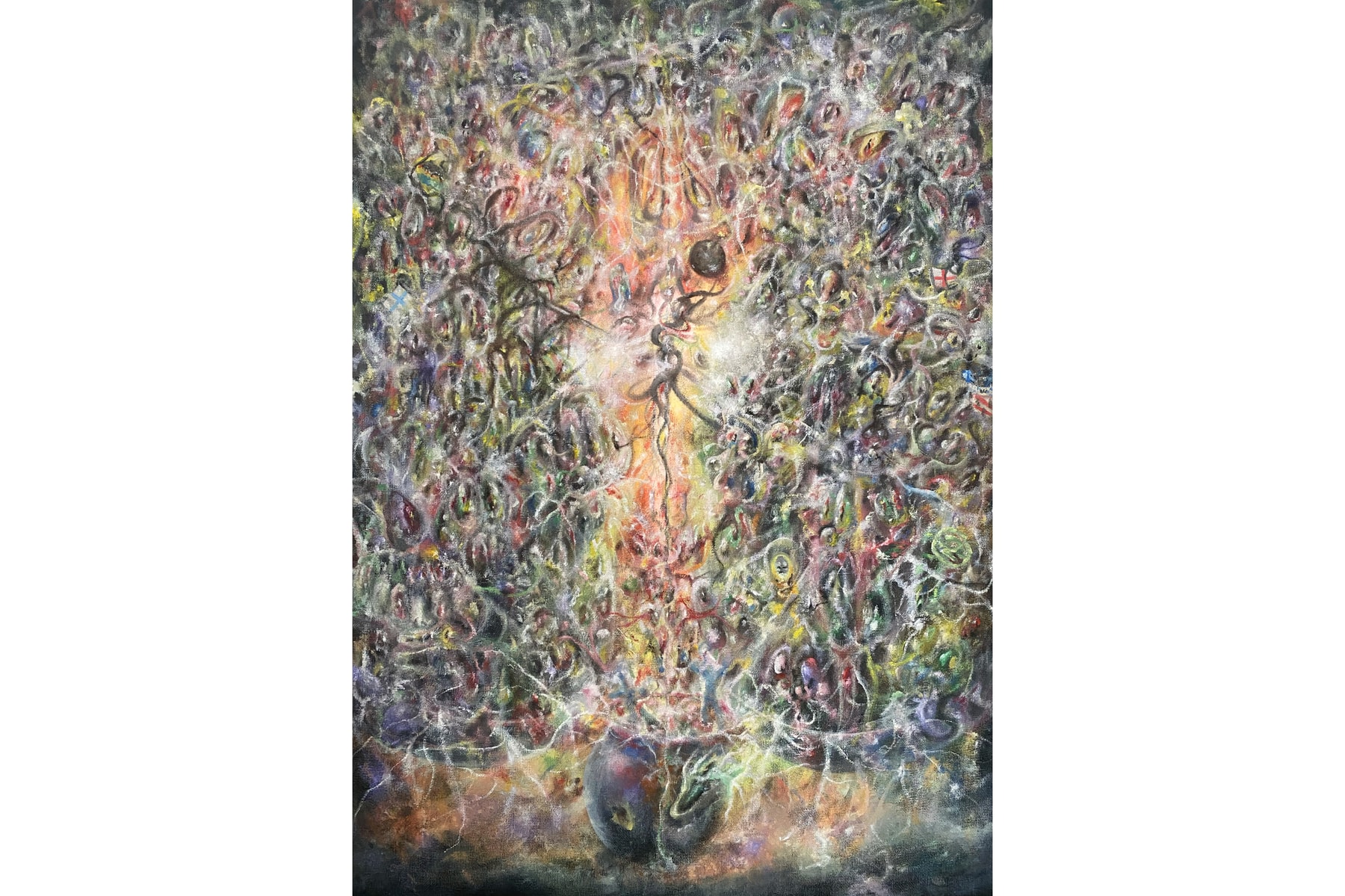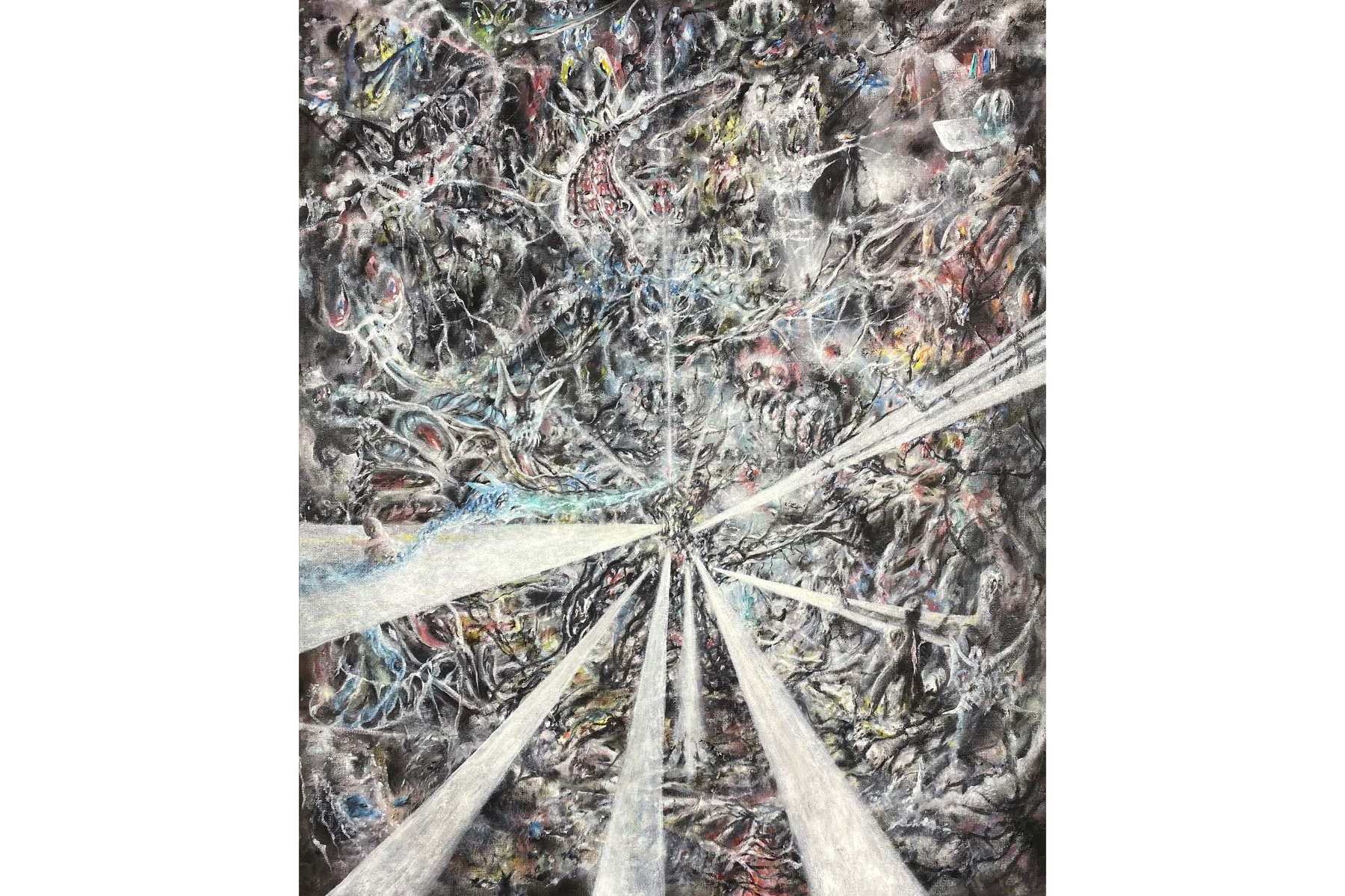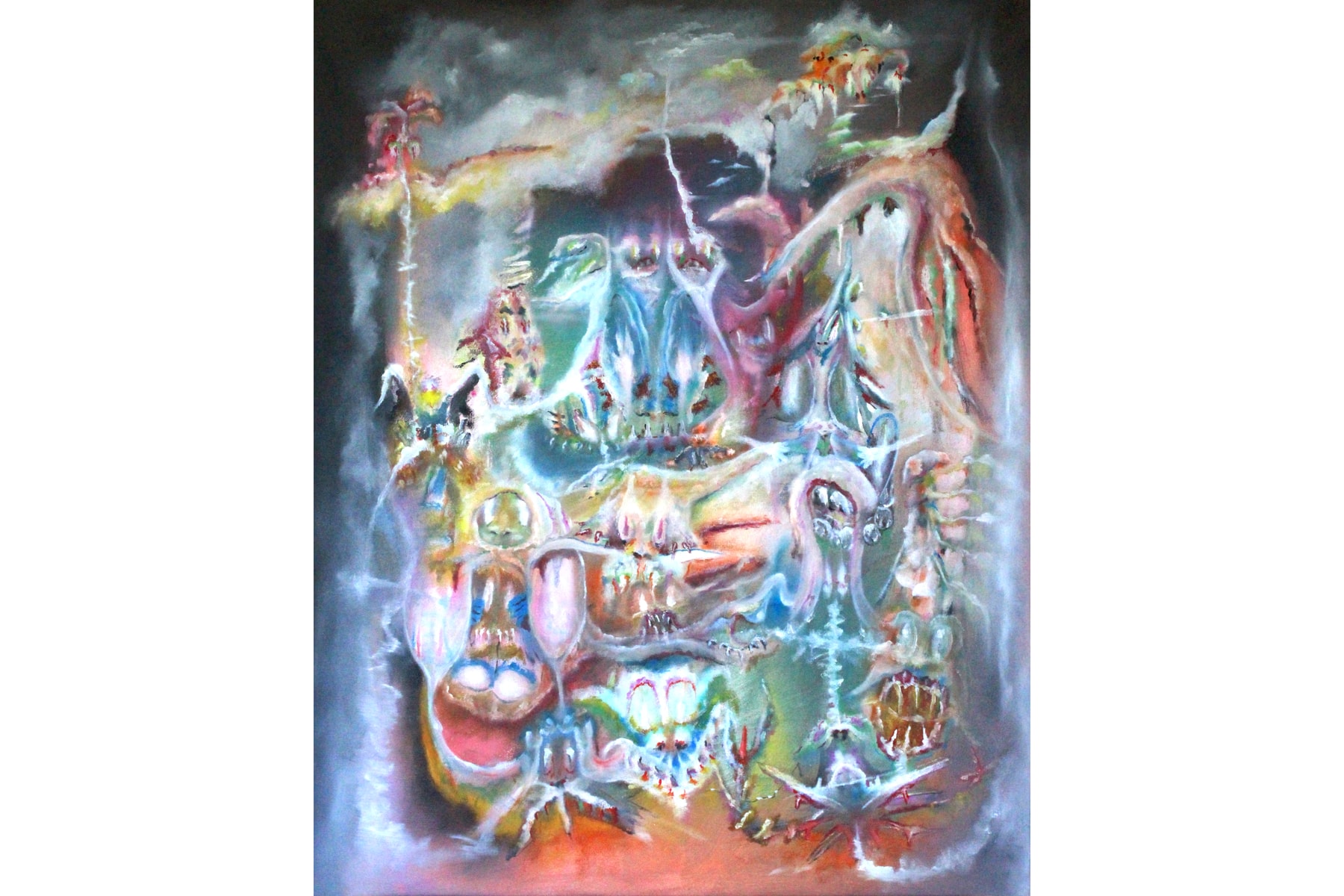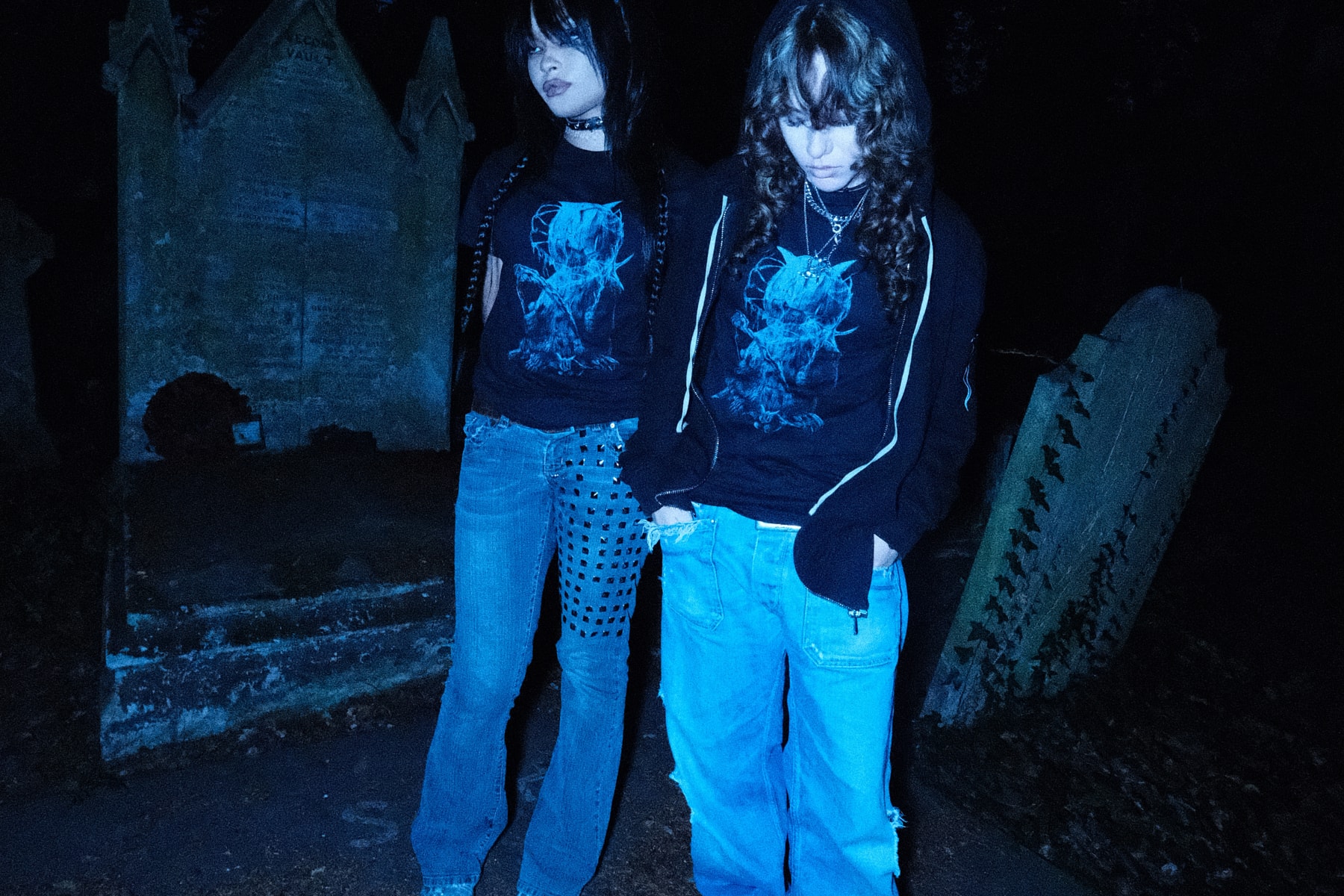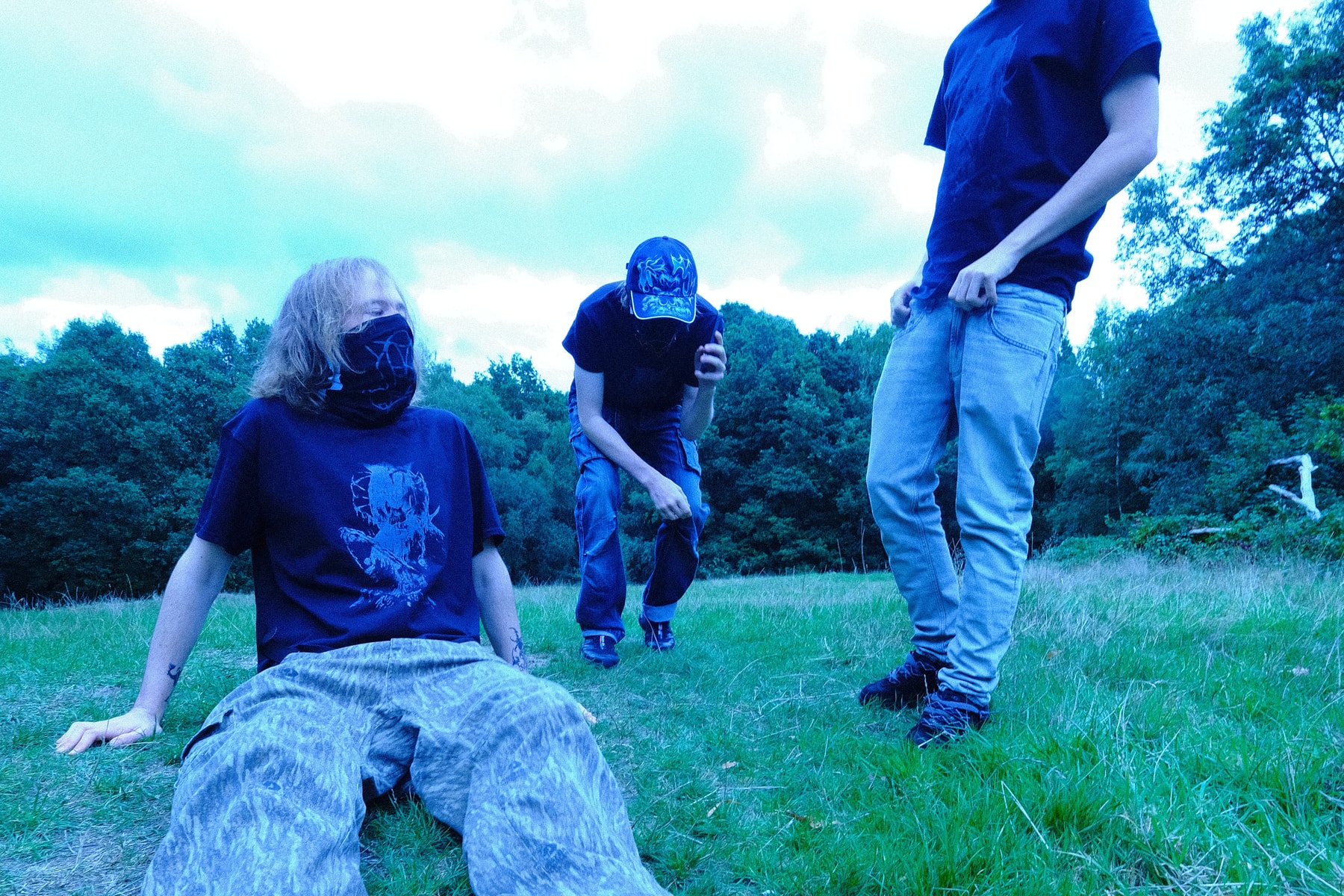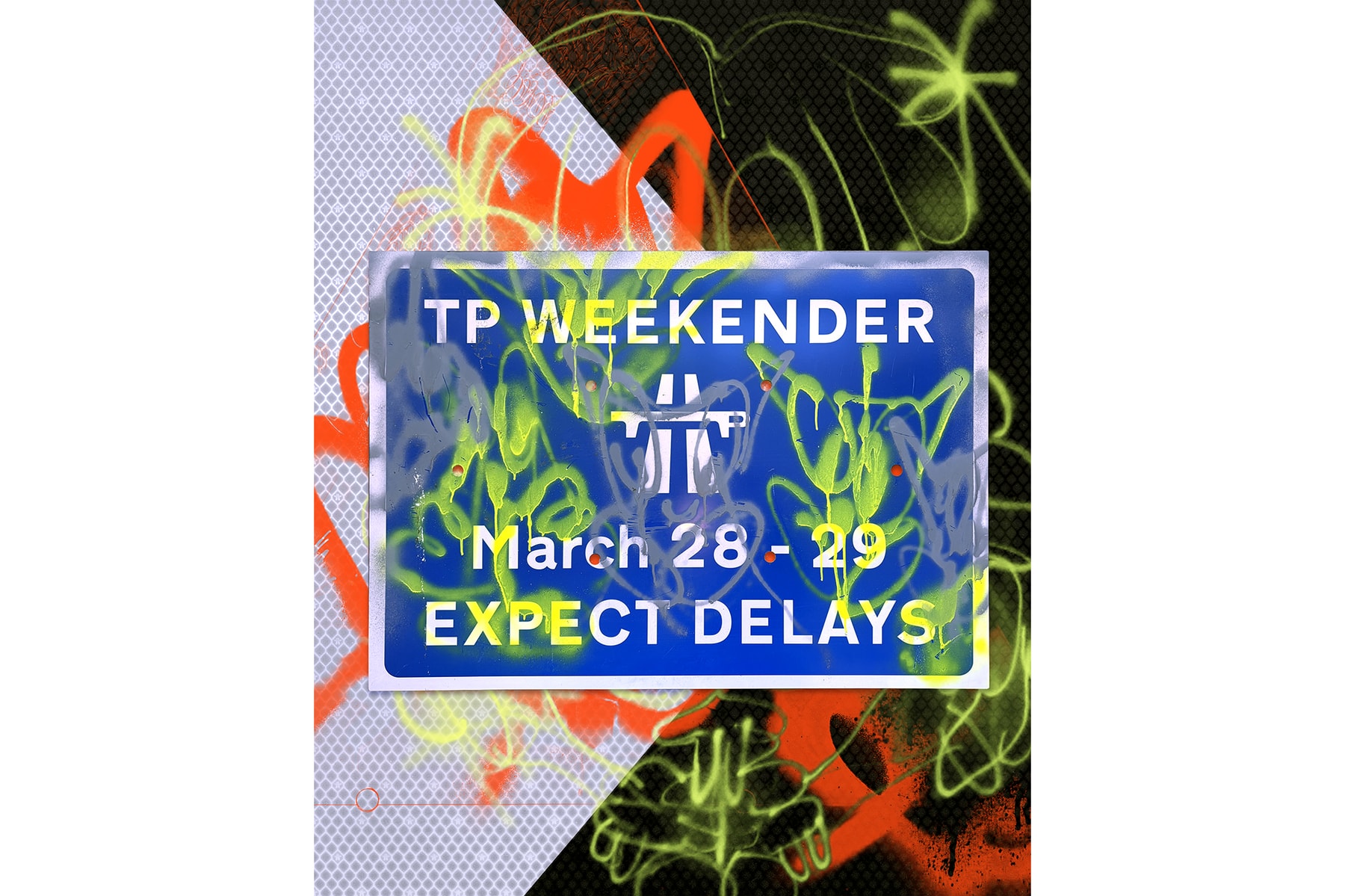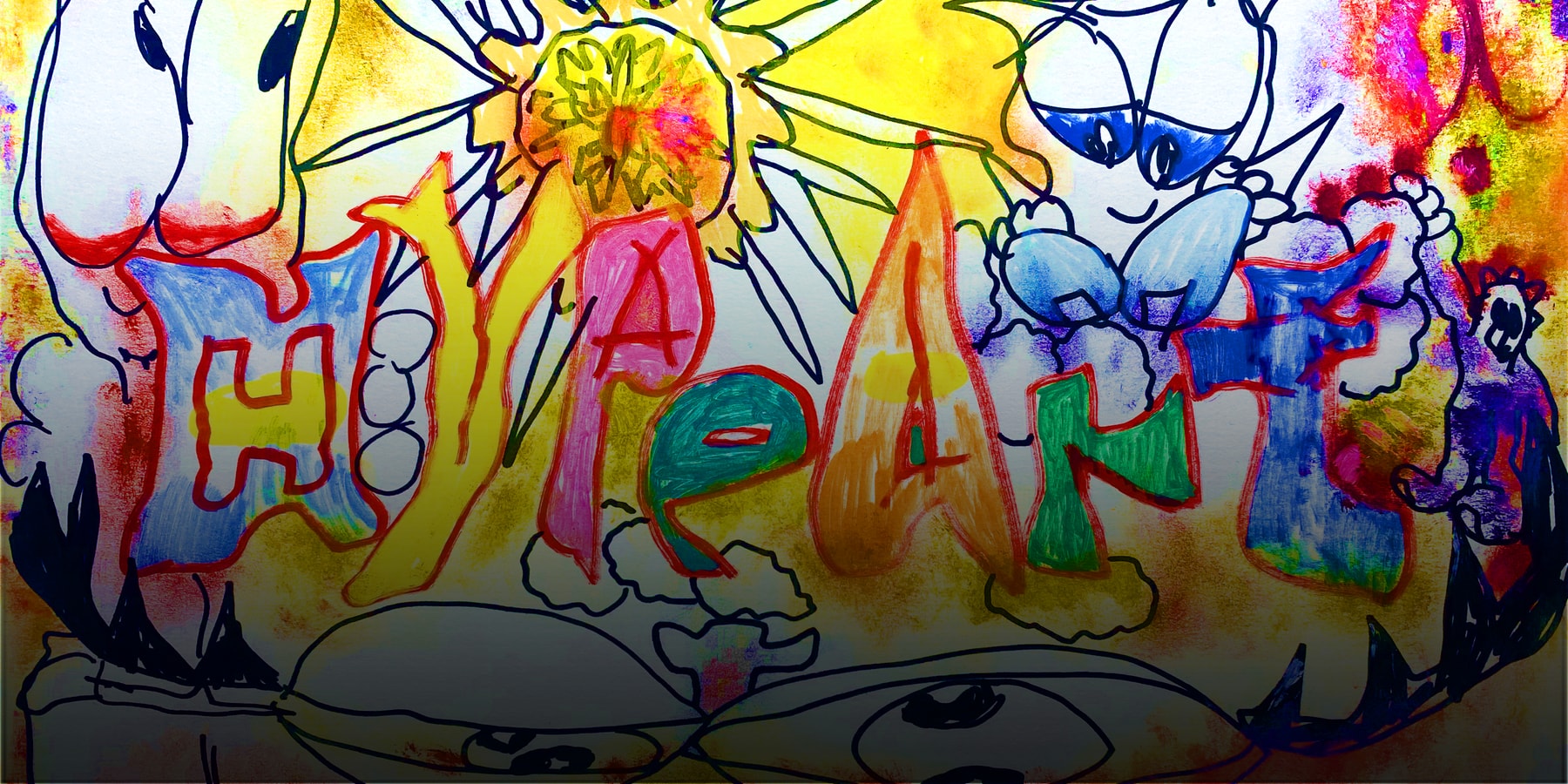

Words by Gabrielle Leung for Hypeart
A queue of Londoners is forming outside of Corsica Studios on a Friday night. The air is thick with smoke, rising from jackets wrapped around bodies preparing for eight straight hours of music, the likes of fakemink, EsDeeKid and Slimzee joining Evian Christ for a legendary TranceParty night. This time, it’s a two-night event (‘TP Weekender’) and a road sign greets you at the entrance, covered in British-Finnish artist Alex Clayton’s unmistakable airbrushed figures, recognizable from the previous club night’s posters and designs.
Clayton is an enigmatic but prolific figure in the underground music scene. He’s produced commissions for Yung Lean and his limited edition, hand-painted T-shirts sell out almost instantly. His distinctive imagery features on album covers for artists like Bloody Shield and in screen visuals for Ice Spice. Appearing in paintings and across T-shirts, football jerseys and beanies, his figures stand solitary, locked in their own worlds, or tangled together — often wielding swords or emerging from dense crowds to grin mischievously at the viewer.
Encountering Clayton’s artwork at a night out, rather than in a white-cube gallery space, feels fitting. “Most of the people I meet and interact with come through music,” says Clayton, when asked about the art and music scenes in London. “The music scene is infinitely more connected, friendly, passionate and willing to experiment to continue pushing the envelope forward.”
His practice reflects this multidisciplinary energy: it’s normal for his presentations to blur distinctions between painting and sound, creating a shared and more embodied, experience for viewing or listening. Earlier this year, Clayton presented a series of painted football jerseys from Helsinki’s local clubs with audiovisual elements, including original soundtracks by artists like Clams Casino during Helsinki Music Week.
“There are a lot of unwritten boring codes in the art world on the whole,” Clayton says. “Coming from a place where I absolutely adore music, it’s a no brainer for me to merge these worlds as much as possible. The way listening to a piece of music with visuals opens up infinite combinations is amazing – it can truly be an extension of the artistic experience.”
For this edition of Pen & Paper, Hypeart caught up with the artist about navigating the art world, his multidisciplinary approach to creating and getting obliterated by strobes at the club.
“The concept of painting something very well was intimidating and cool to me from a young age.”
What was your first introduction to the arts?
My earliest memories of art are passing out from paint fumes on an art class field trip and another time when I made a collage at my grandma’s house that I would keep layering up over and over again by sticking things on and putting it in the freezer to set it. The feeling of making that artwork in a way which made zero sense practically but made all the sense emotionally probably kicked things off, way back then, in how I began to appreciate what making art can do for me and the pure enjoyment of creating it.
Your practice has shifted over the years, from textiles and tufted rugs to angular forms on paper, to more figurative airbrushing and oil painting, and even digital media. What’s been driving that evolution across mediums?
When I started making art consistently and on a regular basis, I felt that my skill level of what I could bring to life was nowhere close to where I wanted it to be. So it always and still does feel like I am continuously learning how to get closer to that place. I feel nowadays that the work I can make would amaze my younger self, and I try to stay grounded in that otherwise it’s just an endless cycle of chasing the dragon.
This is why as my ability grew, so did the mediums I worked in. Simple collage and textile work felt more accessible to me than drawing, shading or working with perspective. The concept of painting something very well was intimidating and cool to me from a young age. During lockdown, my girlfriend taught me how to do simple watercolor paintings and drawings. From there on, year after year, I’ve been looking to evolve my painting skills so I can convey very particular things from my imagination.
“The complex and loud compositional work came about very naturally… it was definitely a response to my inner and outer environment.”
You move between abstraction and figuration with ease. Your figures – who really become characters with their own identities – feel instantly recognizable to your style. What inspires them?
Growing up on the internet in the 2000s and playing all those niche flash games with comedically dark undertones to them. Disney films too — Fantasia was incredible for me. That’s for the more cartoony visuals and themes. When it comes to the edgier imagery, I think some big influences are H.R. Giger and Final Fantasy — the Advent Children movie specifically. I will also give Bladee credit for being an influence on some character themes, as common as I’ve seen it become in respective scenes to purposefully not acknowledge the immense influence he’s had. There is a quality he held with visuals especially in the 2010s that was completely fresh and people very deeply resonated with, including myself.
Your compositions seem to be becoming increasingly more intricate, with characters morphing into and emerging from each other. Do you see this as a response to what is happening around you, or is it a more inward approach to your own world-building?
The complex and loud compositional work came about very naturally. I’ve now come to understand why I was making this work all of a sudden. It was definitely a response to my inner and outer environment. I like these works a lot because they feel especially alive and easy to read — however the viewer is feeling. They can be instantly visceral in a very distressing or pleasurable way. It’s also down to how I look at images and discover things within them. I love staring at artworks and catching my imagination creating things right in front of my eyes.
Walk us through your artistic practice from start to finish.
It’s changed a lot as it used to be more of a hunt to make something highly stimulating to the eye and perhaps less else. It is now just as much about the contexts and themes that are imbued within the work that I make. I will start off with a feeling I want to capture and then link it to something more narrative. The practical aspect is great — I have a lot of fun making my work.
“I love listening to music so much. There is an earth-shattering quality that you can find in a deeply personal and connected music experience.”
We talked previously before about the kind of pretentiousness and exclusivity that dominates the art world, which makes it hard to access and want to be a part of. For me, the traditional ‘white cube’ space doesn’t open itself up to show more experimental work — in a way that is taken seriously. How do you engage with the contemporary art scene here in London?
I absolutely would love to have gallery shows and be in that world. But over my whole time doing this, the doors have never really opened there – instead, they’ve opened everywhere else. If not meeting people through the music scene, then it will be sectors of the fashion and art community, though they seem to find themselves in a similar boat from what I’ve seen.
There are certainly exceptions, with new artists emerging in London and becoming very popular, but it feels less about making art for art’s sake and more about commodifying an avenue that is pretty empty when it comes to ‘cool’ young artists – so it becomes a bit of a cash grab. I would love to see upcoming artists rise through the professional art world who are genuinely talented and boundary-pushing. Hopefully this is something that changes over the next decade, as I feel it also reflects where we are with visual culture in society today.
Music seems to play a significant role in both your creative process and the communities you connect with. Could you share more about its influence on your artistic practice?
I love listening to music so much. There is an earth-shattering quality that you can find in a deeply personal and connected music experience. I would say that it’s the most relevant art form too, if you just see art for art regardless of whether it’s visual or audio. There are so many incredible artists in the music space. If they happened to be painters, they would be just as amazing. They get it.
“There is a real sense of the sublime. I always feel more inspired and motivated to make new work after leaving a show.”
You’ve worked closely with Josh Leary for TranceParty. How did that collaboration come about?
He reached out through Instagram and said he’d been aware of my stuff for a while through mutuals who had bought work from me in the past. Great guy and definitely has opened a lot of doors for me. TranceParty is incredible, I’m a big fan of it myself with what they have done. There’s nothing quite like the clean-cut vision and community brewing inside it.
TranceParty has a very all-encompassing, almost obliterating nature, hitting every sense. Has it influenced your work and the way you create in any way?
It’s something I’m very aware of now with the complex pieces we were discussing. The visual nature of a TranceParty, whether it’s the strobes or designs from David Rudnick, it forms itself into a space that I very much align with thematically. There is a real sense of the sublime. I always feel more inspired and motivated to make new work after leaving a show.
And finally, what’s next for you? Do you have any projects or exhibitions you’re working on?
The main thing I’m working on now is this ACC000 Series which feels very exciting. The first 40 pieces in the series have now been released — they’re all original and hand-painted. The next release will be the beginning of a printed series and transitioning more into a consistent brand. I’ve maybe put off doing a brand for years now, but ultimately, I can’t beat the idea of making clothes that are affordable and that there are multiple of. I want those who are interested in what I do to know they can grab something off my site and it doesn’t cost an arm and a leg to do so. Also, I’m now working with a team of people to bring this to life which has been a much-needed evolution for me. It’s great to have hands-on collaboration with it too.
Photography by Alex Clayton. All artwork courtesy of the artist for Hypeart.





